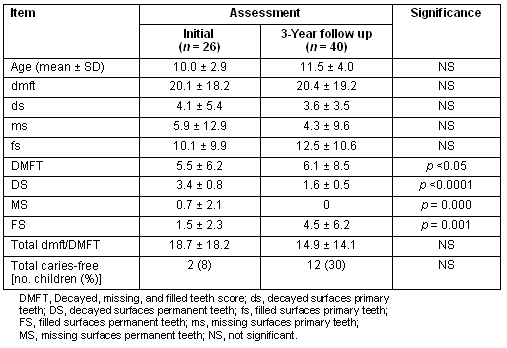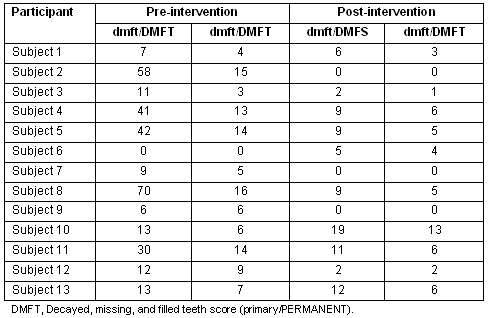Introduction
Surveys of dental health among Aboriginal children in Canada, using scales such as the Decayed, Missing, and Filled Teeth (DMFT) score, indicate that Aboriginal children have 2 to 3 times poorer oral health compared with other populations1-3. A Health Canada report from August 2000 indicates that dental decay rates range from 3 to 5 times greater than in the non-Aboriginal Canadian population4. Statistics from the USA indicate similar discrepancies, with 1999 data showing an incidence of decayed or filled teeth 5 to 6 times greater among Aboriginal Americans compared with non-Aboriginal Americans5. Recent statistics from British Columbia (BC) First Nations children are equally troubling. Causes include giving bottles of milk or apple juice to babies to soothe them, high-sugar diets, and poor or irregular access to dental care. Similar observations of poor dental hygiene and high consumption of sugar-sweetened drinks and food are reported among Aboriginal children living in remote communities in Australia6. Poor oral health is of particular concern now that evidence exists that this chronic inflammatory process may predispose individuals to a higher incidence of diabetes, coronary artery disease and even premature labor7. This makes the issue of oral health all the more pressing in Aboriginal children.
An opportunity arose for the Pediatric Residency Program at The University of British Columbia (UBC) to establish a partnership with the people of Hartley Bay, a remote First Nations community with a population of 200-300. In return for addressing the caommunity's concerns about their children's health, the university's trainees would gain practical experience of First Nations and remote community health issues by being invited into the community. Following several meetings with the elders of the community and the community health staff, oral health was identified as a problem with the potential to show positive results in a relatively short period of time, and have a significant impact on a wide range of First Nations issues - from self-esteem to long-term cardiac health. A variety of possible interventions that could be implemented in the community were identified and presented to the Health Director and Band Council in the community. These included:
- use of traditional soothing methods (eg cradle songs) for infants
- fluoridation of the water
- school-based instruction to improve knowledge and practices around oral health using brush-ins and topical fluoride varnish and/or rinses
- measures to address dietary deficiencies and life style practices in the community as a whole.
The option of a school-based program was selected, and the process and method of delivery were determined by consultation with the community. The rationale was that this was a project involving children, and therefore the program delivery should be school-based and include all children of school age in the community. The school principal and teachers were involved in the design of the program.
We hypothesized that after 3 years of the program there would be a significant decrease in dmft/DMFT (primary teeth/permanent teeth) score in a cross-sectional study, and that pre-post evaluation of individuals would reveal significant improvement in 'cavity free' status.
Methods
The program was approved by The UBC Ethics Review Board. Participants were children who were enrolled in the community school, whose parents provided signed informed consent, and who themselves provided signed assent. All children attending school (100% of those in the community), from kindergarten to grade 10 (at the outset, subsequently grade 12) in the community were invited to participate, and enrollment was 100%. Initially there were 58 children. A convenience sample of 26 (number limited by the time the dentist had in the community) were selected for complete dental examination. The number decreased over time as the community population decreased, and at follow up there were 40 children enrolled (still 100% of the school population), all of whom were available in the community at the time of the follow-up dental examination.
The primary outcome measures were:
- dmft/DMFT (primary/permanent) score, where molars and premolars have five surfaces each, and the remaining teeth have four surfaces each for a possible total score of 128 for 28 teeth, and where a score of 0 indicates no decayed, missing or filled surfaces. dmft/DMFT score tends to increase with age.
- 'Cavity-free/caries-free' status as determined by a dentist not involved in the study, as a better reflection of current rather than long-term oral health than the dmft/DMFT score.
Additional process outcomes were:
- Assessment of oral hygiene and 'time required to treat' evaluations by the Health Canada dental hygienist
- Response of community to ongoing presence of university-based team members
- Response of university trainees to experience in a remote First Nations community.
The Program
The Pediatric Residency program provided teams consisting of two medical residents and a faculty supervisor. Residents were given instruction in oral health, attended a dental clinic, and were provided with information on working with First Nations communities prior to their first visits. Teams visited the community for 3 days approximately every 6 to 8 weeks, providing well-child clinics at the invitation of the community, and implementing and supporting the oral health program. The team worked with the nurses, the school, and the council to maintain the program, and the residents gave health promotion, injury prevention, science career and general interest presentations to the school, the parents, and the elders.
The oral health program consisted of a:
- daily school-based brush-ins after lunch each day, supervised by teachers and/or the community health director, with small rewards weekly for daily participation, and larger prizes for 100% participation for a month
- weekly fluoride rinse
- fluoride varnish applications three times in 10 days every 4 months for those under 9 years of age
- dental health anticipatory guidance by the pediatric residents during well-baby and well-child visits
- classroom presentations by the pediatric residents about a variety of health topics, including oral health.
The community was invited to become a clinical teaching facility of the Faculty of Medicine. Primary care physicians and other health care providers (eg dentists) who usually attend the band members were sent a letter describing the project and assuring them that there was no intent to decrease the utilization of their services or interfere in their relationship with their patients.
Data collected were dmft/DMFT scores, cavity free status, decay-free status, and a brief questionnaire concerning oral health habits. Wilcoxon signed-rank test and Chi-square test were used to test the hypotheses.
Results
Twenty-six children were assessed prior to the intervention. This was 45% of the 58 children then in the community. All 40 children in the community were assessed following the intervention. Initial data and follow-up data for all children are presented (Table 1). There were 13 children who were assessed both at the beginning and at the end of the study. Data for these children are presented (Table 2). Children assessed both before and after the intervention, had significant improvement in dmfs/DMFS (p <0.005) and dmft/DMFT (p <0.05) scores. Data from the questionnaire are presented (Table 3).
Table 1: Mean dmft/DMFT (primary/permanent) scores at initial and follow-up assessments (by F-test)

Table 2: Data for children assessed both before and after the intervention

Table 3: Results of a brief questionnaire on oral health behaviours

The program is still in progress. One hundred percent of the children remain enrolled, and pride in their success and motivation of each other is very evident. The community can see a marked improvement and remains very positive about the program. Teachers award prizes weekly, monthly and annually for participation, and the school maintains a wall of photographs of children who are caries free as a measure of their success.
Interim assessments showed that at the end of the first year, 41% of the children had no new cavities. Two years into the program, the government dental hygienist reported that the majority of the children had visibly better oral hygiene and the 'time required to treat' for restoration had decreased significantly from 117.6 min for 58 children in 2002 to 68.4 min for 49 children in 2004 (χ2 = 25.54, p <0.001). The 'time required to treat' for preventative therapy had decreased from 421 min (n = 55) to 301 min (n = 49) (p = 0.025). There was no difference in the 'time required to treat' for extraction of teeth (χ2 = .093, p <1.00).
The response of the community was consistently positive, and resulted in requests for additional interventions, including immunization and screening for type 2 diabetes. The pediatric trainees reported significant increase in insight and understanding of the issues and obstacles faced by their aboriginal patients in remote communities. Evaluations included responses such as 'this was the best rotation' and 'this was the most valuable learning experience in the program'. Royal College of Physicians and Surgeons' (Canada) review of UBC residency program in 2007 concluded that the Hartley Bay experience was one of the program's greatest strengths.
Discussion
The community- and university-supported, school-based, collaborative oral health program improved oral health among children in a remote First Nations community and provided valuable educational opportunities for pediatric trainees.
At pre-intervention assessment, 92% of children had at least one cavity. This was consistent with other recent Canadian surveys. A 1999 survey of dental health among children aged 18 to 36 months in a First Nations community in Southern BC found that 31 of 35 (89%) children had at least one carious lesion, and 14% of primary tooth surfaces were decayed. Examination of similarly-aged children in a First Nations community in the Cariboo region revealed that, on average, each child had approximately five decayed primary teeth, and only 21% of children were cavity free8. Data from studies in the USA show that the rate of carious lesions is not as high, with 35% of school children aged 6 to 14 years, and 11.5% of children aged 15 to 19 years having no caries5.
Our results also indicate that there was a significant improvement, assessed by questionnaire, in all oral health behaviours, except brushing teeth at home, which decreased, possibly because children were brushing their teeth at school. Programs that incorporate ongoing enthusiastic support, education, and follow up from visiting multidisciplinary health professionals may have a positive impact on behaviours that affect oral health among children living in remote Aboriginal communities. This may allow healthcare providers to address the oral health problems that are reported to affect Aboriginal children living in remote communities throughout the world1-6.
The partnership proved to be more successful than either group anticipated. The visits of the trainees are eagerly anticipated by both the trainees and the community. The dental education received by the pediatric trainees is supported by Mouradian et al. in their call for medical-dental collaborations to improve health disparities9, and by Gussy et al. in their study that found that young children are more likely to receive pediatric care than dental care, and that thus primary care-givers and pediatricians would be well placed to offer advice that could help reduce early childhood caries10.
Both groups have learned valuable lessons from one another11,12. The oral health program has led to community requests for other initiatives, notably a nutrition survey and an immunization program that now has 100% of the children fully immunized.
The fact that the partnership has thrived and expanded is due in large part to the success and popularity of its central component, the oral health program. This choice to address oral health was driven by identified community need and also provided a realistic and achievable goal. This supports the philosophy that achieving a small success and then building on it will promote trust and open other avenues of collaboration.
It was evident at the recent international conference on Inuit and Native American Child Health held jointly with the 2005 17th Annual IHS Research Conference
One additional element for the program that we will be proposing to the community is chlorhexidine varnish for new mothers, since this simple process has been shown by others to significantly reduce early childhood caries13.
In partnership with Makarere University in Kampala, we have also taken the Brighter Smiles program to Uganda, where over 1100 children were enrolled in four remote communities. The Brighter Smiles Africa program includes annual visits by multidisciplinary UBC-based teams, including such disciplines as medical, dental, economics, engineering, and culture.
Conclusion
A community- and university-supported, school-based, collaborative oral health program improved oral health among children in a remote First Nations community.
References
1. Bedford WR, Davey KW. Indian and Inuit dental care in Canada; the past, the present and the future. Journal of the Canada Dental Association 1993; 59: 130-132.
2. Harrison RL, Davis DW. Caries experience of Native children of British Columbia, Canada, 1980-1988. Community Dentistry and Oral Epidemiology 1993; 21: 102-107.
3. Health Canada. A Statistical profile on the health of First Nations in Canada. (Online) 2000. Available: http://www.hc-sc.gc.ca/fnih-spni/pubs/gen/stats_profil_e.html (Accessed 1 May 2003).
4. First Nations Inuit Health Branch Community Programs. 1999-2000 Annual Review. Ottawa: Health Canada, 2000.
5. Sekiguchi E, Guay AH, Brown LJ, Spangler TJ. Improving the oral health of Alaska natives. American Journal of Public Health 2005; 95: 769-773
6. Jamieson LM, Bailie RS, Beneforti M, Koster CR, Spencer AJ. Dental self-care and dietary characteristics of remote-living Indigenous children. Rural and Remote Health 6: 503. (Online) 2006. Available: www.rrh.org.au (Accessed 2 April 2008).
7. Kim J, Amar S. Periodontal disease and systemic conditions: a bidirectional relationship. Odontology 2006; 94: 10-21.
8. Harrison R, White L. A community-based approach to infant and child oral health promotion in a British Columbia First Nations community. Canadian Journal of Community Dentistry 1997; 12: 7-14.
9. Mouradian WE, Huebner C, DePaola D. Addressing health disparities through dental-medical collaborations, Part III: Leadership for the public good. Journal of Dental Education 2004; 68: 505-512.
10. Gussy MG, Water EG, Walsh O, Kilpatrick NM. Early childhood caries: current evidence for aetiology and prevention. Journal of Paediatrics and Child Health 2006; 42: 37-43.
11. Harrison R, Macnab AJ, Duffy D, Benton, D. Brighter Smiles. Health promotion and service-learning in a remote first nation's community. Canadian Journal of Public Health 2006; 97: 237-240
12. Macnab A, Rassekh R, Lai YH, Benton D, Duffy D, Gagnon F et al. Development of a symbiotic relationship with a remote First Nations Community leading to a collaborative school-based oral health program. IHS Primary Care Provider 2005; 30: 230-233.
13. Gripp VC, Schlagenhauf U. Prevention of early mutans streptococci transmission in infants by professional tooth cleaning and chlorhexidine varnish treatment of the mother. Caries Research 2002; 36: 366-372.

